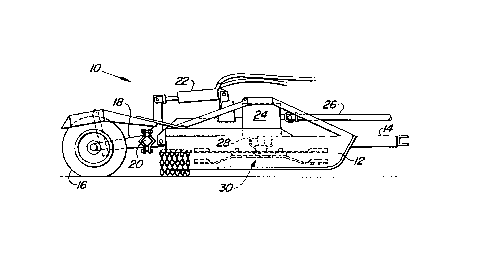Some of the information on this Web page has been provided by external sources. The Government of Canada is not responsible for the accuracy, reliability or currency of the information supplied by external sources. Users wishing to rely upon this information should consult directly with the source of the information. Content provided by external sources is not subject to official languages, privacy and accessibility requirements.
Any discrepancies in the text and image of the Claims and Abstract are due to differing posting times. Text of the Claims and Abstract are posted:
| (12) Patent: | (11) CA 2178535 |
|---|---|
| (54) English Title: | SHREDDING ATTACHMENT FOR ROTARY CUTTER |
| (54) French Title: | ORGANE DE DECHIQUETAGE POUR FRAISE |
| Status: | Expired and beyond the Period of Reversal |
| (51) International Patent Classification (IPC): |
|
|---|---|
| (72) Inventors : |
|
| (73) Owners : |
|
| (71) Applicants : |
|
| (74) Agent: | BORDEN LADNER GERVAIS LLP |
| (74) Associate agent: | |
| (45) Issued: | 1999-08-31 |
| (22) Filed Date: | 1996-06-07 |
| (41) Open to Public Inspection: | 1997-03-01 |
| Examination requested: | 1996-06-07 |
| Availability of licence: | N/A |
| Dedicated to the Public: | N/A |
| (25) Language of filing: | English |
| Patent Cooperation Treaty (PCT): | No |
|---|
| (30) Application Priority Data: | ||||||
|---|---|---|---|---|---|---|
|
A rotary cutter includes first and second pairs of blades pivotally mounted to opposite ends of a first blade holder, with the first pair of blades being spaced vertically above the second pair of blades. A third pair of blades for enhancing the shredding characteristic of the cutter are mounted to the opposite ends of a second blade holder having a longitudinal axis disposed perpendicular to a longitudinal axis of the first blade holder. The third pair of blades are located to operate at a height in between the respective heights of operation of the first and second blades and are located to trace a path which is radially inward from thattraced by the first and second blades. The second bl ade holder is mounted to thefirst blade holder exclusive of the drive shaft to which the first blade holder is coupled and may be removed or assembled without disturbing the mounting of the first blade holder.
Un couteau rotatif comprend une première et une deuxième paire de lames montées de façon pivotante à des extrémités opposées d'un premier support de lame, la première paire de lames étant espacée verticalement au-dessus de la deuxième paire de lames. Une troisième paire de lames pour renforcer la caractéristique de déchiquetage du couteau rotatif est montée sur les extrémités opposées d'un deuxième support de lame dont l'axe longitudinal est perpendiculaire à l'axe longitudinal du premier support de lame. La troisième paire de lames est située de manière à fonctionner à une hauteur intermédiaire entre les hauteurs de fonctionnement respectives des premières et deuxièmes lames et est placée de manière à tracer un chemin qui est radialement vers l'intérieur de celui tracé par les premières et deuxièmes lames. Le deuxième support de lame est monté sur le premier support de lame excluant l'arbre auquel le premier support de lame est couplé et peut être retiré ou assemblé sans déranger le montage du premier support de lame.
Note: Claims are shown in the official language in which they were submitted.
Note: Descriptions are shown in the official language in which they were submitted.

2024-08-01:As part of the Next Generation Patents (NGP) transition, the Canadian Patents Database (CPD) now contains a more detailed Event History, which replicates the Event Log of our new back-office solution.
Please note that "Inactive:" events refers to events no longer in use in our new back-office solution.
For a clearer understanding of the status of the application/patent presented on this page, the site Disclaimer , as well as the definitions for Patent , Event History , Maintenance Fee and Payment History should be consulted.
| Description | Date |
|---|---|
| Time Limit for Reversal Expired | 2016-06-07 |
| Letter Sent | 2015-06-08 |
| Inactive: IPC from MCD | 2006-03-12 |
| Grant by Issuance | 1999-08-31 |
| Inactive: Cover page published | 1999-08-30 |
| Inactive: Final fee received | 1999-05-21 |
| Pre-grant | 1999-05-21 |
| Notice of Allowance is Issued | 1999-01-07 |
| Notice of Allowance is Issued | 1999-01-07 |
| Letter Sent | 1999-01-07 |
| Inactive: Approved for allowance (AFA) | 1998-09-23 |
| Inactive: Inventor deleted | 1998-03-18 |
| Inactive: Status info is complete as of Log entry date | 1997-12-02 |
| Inactive: Application prosecuted on TS as of Log entry date | 1997-12-02 |
| Amendment Received - Voluntary Amendment | 1997-10-31 |
| Application Published (Open to Public Inspection) | 1997-03-01 |
| All Requirements for Examination Determined Compliant | 1996-06-07 |
| Request for Examination Requirements Determined Compliant | 1996-06-07 |
There is no abandonment history.
The last payment was received on 1999-06-04
Note : If the full payment has not been received on or before the date indicated, a further fee may be required which may be one of the following
Please refer to the CIPO Patent Fees web page to see all current fee amounts.
Note: Records showing the ownership history in alphabetical order.
| Current Owners on Record |
|---|
| DEERE & COMPANY |
| Past Owners on Record |
|---|
| HENRY FRIESEN |